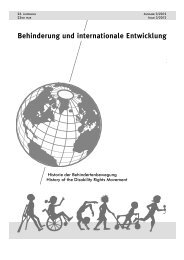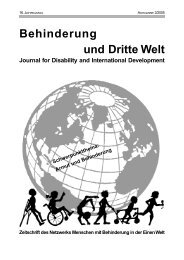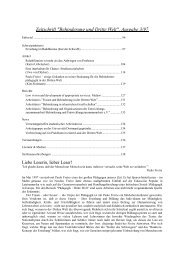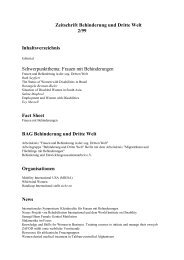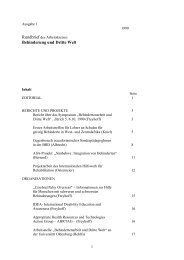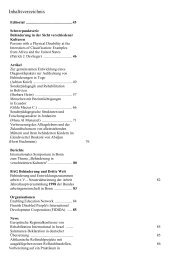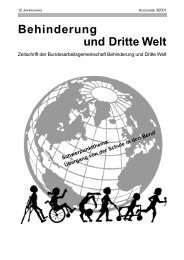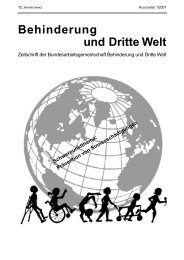Disaster and Disability in Bangladesh - Behinderung und Dritte Welt
Disaster and Disability in Bangladesh - Behinderung und Dritte Welt
Disaster and Disability in Bangladesh - Behinderung und Dritte Welt
You also want an ePaper? Increase the reach of your titles
YUMPU automatically turns print PDFs into web optimized ePapers that Google loves.
A RTIKELConclusionThis paper has addressed the potential applicationof social capital to the disability <strong>and</strong> developmentdebate, a debate that is as complex asit is marg<strong>in</strong>alised, <strong>and</strong> often bereft of discipl<strong>in</strong>arycross-fertilisation. Local complexities, contexts,<strong>and</strong> cultures, require a degree of attentionto people, what they are do<strong>in</strong>g on thegro<strong>und</strong>, their needs <strong>and</strong> aspirations, capabilities<strong>and</strong> so on. While valuable <strong>and</strong> rich ethnographic<strong>in</strong>puts emphasis<strong>in</strong>g the primacy of contexthave emerged from fields such as anthropology(see for example Ingstad <strong>and</strong> Whyte1995, 2007), <strong>and</strong> while development studieshas long been address<strong>in</strong>g issues aro<strong>und</strong> poverty<strong>and</strong> its reduction (<strong>and</strong> has much relevanceto disability), these are often rendered <strong>in</strong>visible<strong>in</strong> the global disability debate. The Western disabilitystudies <strong>and</strong> its ma<strong>in</strong> tenets are all too oftenexported across cultures (through development<strong>and</strong> other organisations, of <strong>and</strong> for disabledpeople, North <strong>and</strong> South), often with lackof engagement with the realities of disabledlives <strong>in</strong> complex <strong>and</strong> often mis<strong>und</strong>erstood sett<strong>in</strong>gs,<strong>and</strong> how these imp<strong>in</strong>ge on issues of applicabilityof epistemologies across cultures.Lack of engagement with discipl<strong>in</strong>es such asdevelopment studies rema<strong>in</strong>s problematic,s<strong>in</strong>ce these, for better or for worse, have alonger (albeit turbulent) history of engagementwith issues of poverty, gender, <strong>and</strong> ethnicityamong others <strong>in</strong> the majority world, <strong>and</strong> fromwhich lessons can be usefully drawn. At thevery least, this can <strong>in</strong>itiate much needed debatebetween disability <strong>and</strong> development studies ifthe phrase disability <strong>and</strong> development is to everbecome a concrete currency the equivalent ofgender <strong>and</strong> development that decades downthe l<strong>in</strong>e rema<strong>in</strong>s a (albeit a much engagedwith) work <strong>in</strong> progress.The start<strong>in</strong>g po<strong>in</strong>t perhaps is to <strong>und</strong>erst<strong>and</strong>that poverty rema<strong>in</strong>s an impend<strong>in</strong>g reality <strong>in</strong>which disability is enveloped, <strong>and</strong> poverty <strong>and</strong>disability are <strong>in</strong> turn engrossed <strong>in</strong> complex (<strong>and</strong>seldom <strong>und</strong>erstood) cultures, beliefs, ideologies,<strong>and</strong> communities. At the most basic level,it po<strong>in</strong>ts towards the imperative of <strong>und</strong>erst<strong>and</strong><strong>in</strong>gpoverty <strong>and</strong> its implications by those engaged<strong>in</strong> the study of disability across cultures.In this process, the expansion of bo<strong>und</strong>aries(whether discipl<strong>in</strong>ary or simply those of dialogue),rema<strong>in</strong> perhaps most important tomove for example beyond the views of socialrelationships solely as processes of disablement,to engage with the notion that communitiesfor better or for worse, still matter, <strong>in</strong> someplaces more than others, cont<strong>in</strong>ue to embrace<strong>and</strong> often ensure survival of most poor people(disabled <strong>and</strong> non-disabled) <strong>and</strong> consequentlyneed to be <strong>und</strong>erstood further <strong>and</strong> re<strong>in</strong>forced.Notes1 The term majority world is used to refer to countrieswhere the bulk of the world’s population reside <strong>and</strong>where poverty is largely concentrated. Similar toStone (1999), the term is employed to del<strong>in</strong>eate thepower <strong>and</strong> resource differentials with rich countriesthat host a smaller percentage of the world’s populationbut where wealth is largely concentrated <strong>and</strong>controlled, <strong>and</strong> which exert <strong>in</strong>fluence <strong>and</strong> power (economically,politically, socially, <strong>and</strong> culturally) over poorcountries.2 While it is beyond the scope of this paper, it is importantto emphasise that the term human capital “constitutesthe <strong>in</strong>dividual as an economic rather than asocial actor, <strong>and</strong> as a competitive <strong>in</strong>dividual ratherthan a co-operative social be<strong>in</strong>g“ (Dean et al. 2005:31) <strong>and</strong> often translates <strong>in</strong>to pressures <strong>in</strong> the majorityworld for educational <strong>and</strong> skills provision, with thetarget of enhanc<strong>in</strong>g labour force participation, productivity<strong>and</strong> more broadly economic growth <strong>in</strong> aglobalised economy. Dean et al. (2005) go on to emphasisethat this approach has often translated <strong>in</strong>policies with the proclaimed aim of creat<strong>in</strong>g opportunitiesfor the poor, without tak<strong>in</strong>g account of thestructural problems creat<strong>in</strong>g <strong>and</strong> perpetuat<strong>in</strong>g poverty,<strong>and</strong> hence the responsibility aga<strong>in</strong> falls squarelyupon the shoulders of poor people, while leav<strong>in</strong>gstructures unaltered.3 The neoliberal agenda is one premised on “…an entirestructure of beliefs fo<strong>und</strong>ed on right-w<strong>in</strong>g, but notconservative, ideas about <strong>in</strong>dividual freedom, politicaldemocracy, self-regulat<strong>in</strong>g markets, <strong>and</strong> entrepreneurship“(Peet, 2003:8) <strong>and</strong> one that often translates<strong>in</strong>to a set of prescriptive one size fits all measures forcountries <strong>in</strong> the majority world (described <strong>in</strong> text <strong>in</strong>relation to structural adjustment programmes).ReferencesBIRD, K./HULME, D./MOORE, K./SHEPHERD, A. (2002):Chronic poverty <strong>and</strong> remote rural areas. UK: Instituteof Development Policy <strong>and</strong> ManagementBOLT, V.J./BIRD, K. (2003). The Intrahousehold DisadvantagesFramework: A Framework for the Analysis of Intra-householdDifference <strong>and</strong> Inequality. UK: CPRCBOURDIEU, P. (1983): Forms of capital. In: Richards, J.C,ed, H<strong>and</strong>book of Theory <strong>and</strong> Research for the Sociologyof Education. New York, Greenwood Press, 241-258BURT, R.S. (1997). The cont<strong>in</strong>gent value of social capital.Adm<strong>in</strong>istrative Science Quarterly, 42: 339-65.CBM (2007): <strong>Disability</strong> <strong>and</strong> Development Policy. Germany:CBMZeitschrift Beh<strong>in</strong>derung <strong>und</strong> <strong>Dritte</strong> <strong>Welt</strong> 1/201011



